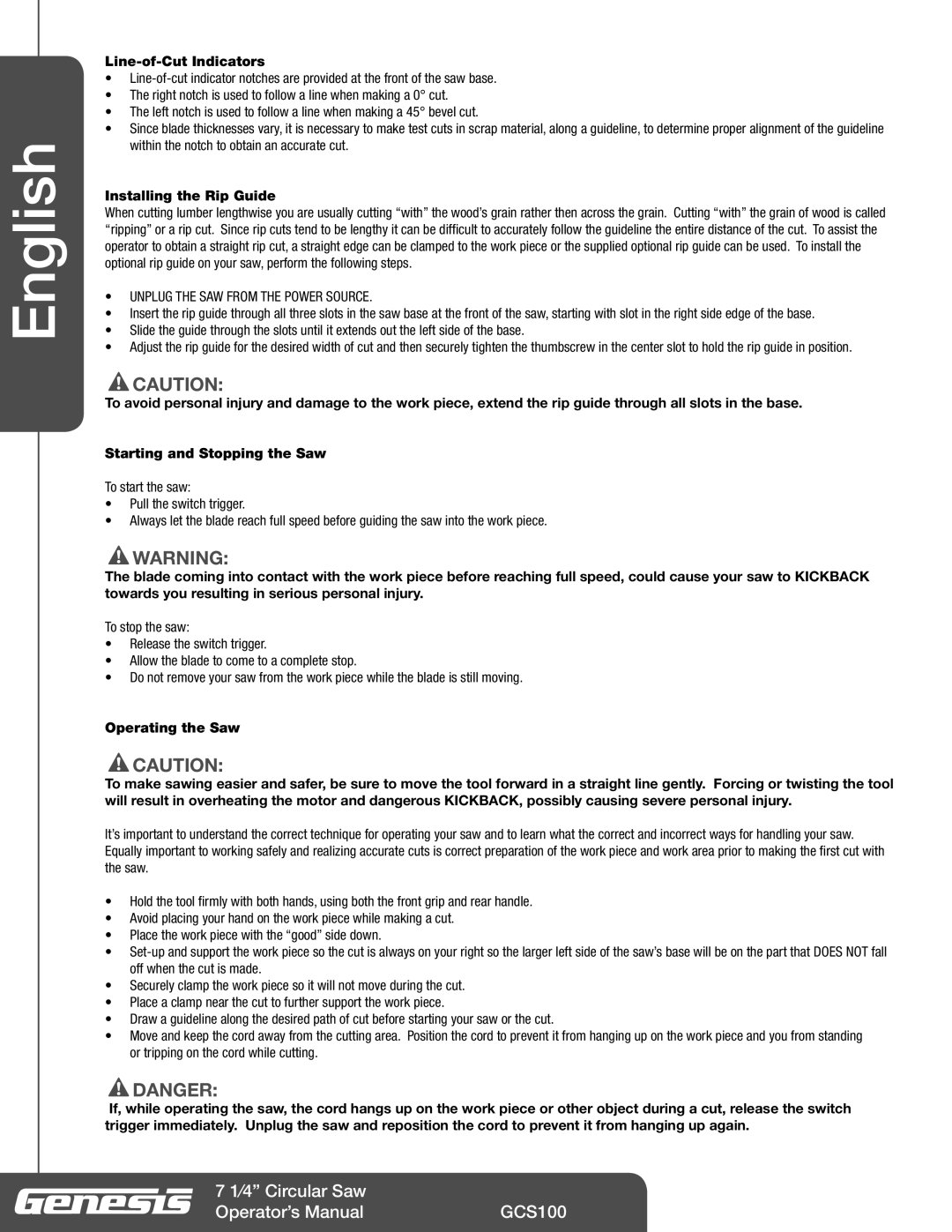
English
Line-of-Cut Indicators
•
•The right notch is used to follow a line when making a 0° cut.
•The left notch is used to follow a line when making a 45° bevel cut.
•Since blade thicknesses vary, it is necessary to make test cuts in scrap material, along a guideline, to determine proper alignment of the guideline within the notch to obtain an accurate cut.
Installing the Rip Guide
When cutting lumber lengthwise you are usually cutting “with” the wood’s grain rather then across the grain. Cutting “with” the grain of wood is called “ripping” or a rip cut. Since rip cuts tend to be lengthy it can be difficult to accurately follow the guideline the entire distance of the cut. To assist the operator to obtain a straight rip cut, a straight edge can be clamped to the work piece or the supplied optional rip guide can be used. To install the optional rip guide on your saw, perform the following steps.
•UNPLUG THE SAW FROM THE POWER SOURCE.
•Insert the rip guide through all three slots in the saw base at the front of the saw, starting with slot in the right side edge of the base.
•Slide the guide through the slots until it extends out the left side of the base.
•Adjust the rip guide for the desired width of cut and then securely tighten the thumbscrew in the center slot to hold the rip guide in position.
![]() caution:
caution:
To avoid personal injury and damage to the work piece, extend the rip guide through all slots in the base.
Starting and Stopping the Saw
To start the saw:
•Pull the switch trigger.
•Always let the blade reach full speed before guiding the saw into the work piece.
![]() Warning:
Warning:
The blade coming into contact with the work piece before reaching full speed, could cause your saw to KICKBACK towards you resulting in serious personal injury.
To stop the saw:
•Release the switch trigger.
•Allow the blade to come to a complete stop.
•Do not remove your saw from the work piece while the blade is still moving.
Operating the Saw
![]() caution:
caution:
To make sawing easier and safer, be sure to move the tool forward in a straight line gently. Forcing or twisting the tool will result in overheating the motor and dangerous KICKBACK, possibly causing severe personal injury.
It’s important to understand the correct technique for operating your saw and to learn what the correct and incorrect ways for handling your saw. Equally important to working safely and realizing accurate cuts is correct preparation of the work piece and work area prior to making the first cut with the saw.
•Hold the tool firmly with both hands, using both the front grip and rear handle.
•Avoid placing your hand on the work piece while making a cut.
•Place the work piece with the “good” side down.
•
•Securely clamp the work piece so it will not move during the cut.
•Place a clamp near the cut to further support the work piece.
•Draw a guideline along the desired path of cut before starting your saw or the cut.
•Move and keep the cord away from the cutting area. Position the cord to prevent it from hanging up on the work piece and you from standing or tripping on the cord while cutting.
![]() DANGER:
DANGER:
If, while operating the saw, the cord hangs up on the work piece or other object during a cut, release the switch trigger immediately. Unplug the saw and reposition the cord to prevent it from hanging up again.
7 1⁄4” Circular Saw |
|
Operator’s Manual | GCS100 |
